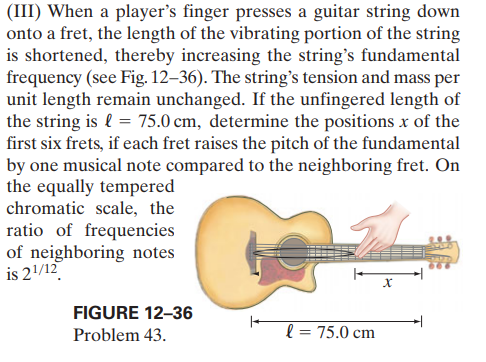(III) When a player's finger presses a guitar string down onto a fret, the length of the vibrating portion of the string is shortened, thereby increasing the string's fundamental frequency (see Fig. 12–36). The string's tension and mass per unit length remain unchanged. If the unfingered length of the string is l = 75.0 cm, determine the positions x of the first six frets, if each fret raises the pitch of the fundamental by one musical note compared to the neighboring fret. On the equally tempered chromatic scale, the ratio of frequencies of neighboring notes is 21/12 FIGURE 12–36 Problem 43. l = 75.0 cm
(III) When a player's finger presses a guitar string down onto a fret, the length of the vibrating portion of the string is shortened, thereby increasing the string's fundamental frequency (see Fig. 12–36). The string's tension and mass per unit length remain unchanged. If the unfingered length of the string is l = 75.0 cm, determine the positions x of the first six frets, if each fret raises the pitch of the fundamental by one musical note compared to the neighboring fret. On the equally tempered chromatic scale, the ratio of frequencies of neighboring notes is 21/12 FIGURE 12–36 Problem 43. l = 75.0 cm
Classical Dynamics of Particles and Systems
5th Edition
ISBN:9780534408961
Author:Stephen T. Thornton, Jerry B. Marion
Publisher:Stephen T. Thornton, Jerry B. Marion
Chapter12: Coupled Oscillations
Section: Chapter Questions
Problem 12.24P
Related questions
Question

Transcribed Image Text:(III) When a player's finger presses a guitar string down
onto a fret, the length of the vibrating portion of the string
is shortened, thereby increasing the string's fundamental
frequency (see Fig. 12–36). The string's tension and mass per
unit length remain unchanged. If the unfingered length of
the string is l = 75.0 cm, determine the positions x of the
first six frets, if each fret raises the pitch of the fundamental
by one musical note compared to the neighboring fret. On
the equally tempered
chromatic scale, the
ratio of frequencies
of neighboring notes
is 21/12
FIGURE 12–36
Problem 43.
l = 75.0 cm
Expert Solution
This question has been solved!
Explore an expertly crafted, step-by-step solution for a thorough understanding of key concepts.
This is a popular solution!
Trending now
This is a popular solution!
Step by step
Solved in 3 steps

Recommended textbooks for you

Classical Dynamics of Particles and Systems
Physics
ISBN:
9780534408961
Author:
Stephen T. Thornton, Jerry B. Marion
Publisher:
Cengage Learning

University Physics Volume 1
Physics
ISBN:
9781938168277
Author:
William Moebs, Samuel J. Ling, Jeff Sanny
Publisher:
OpenStax - Rice University

Classical Dynamics of Particles and Systems
Physics
ISBN:
9780534408961
Author:
Stephen T. Thornton, Jerry B. Marion
Publisher:
Cengage Learning

University Physics Volume 1
Physics
ISBN:
9781938168277
Author:
William Moebs, Samuel J. Ling, Jeff Sanny
Publisher:
OpenStax - Rice University